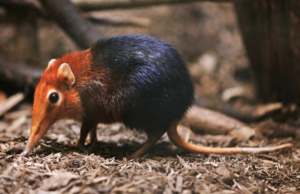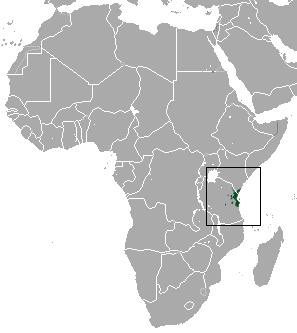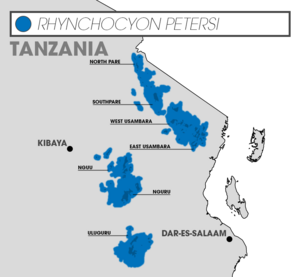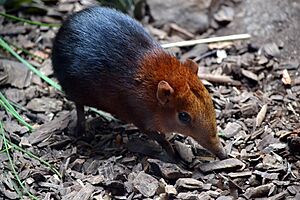Black and rufous sengi facts for kids
Quick facts for kids Black and rufous sengi |
|
|---|---|
 |
|
| Conservation status | |
| Scientific classification | |
| Genus: |
Rhynchocyon
|
| Species: |
petersi
|
 |
|
| Geographic range | |
The black and rufous sengi, also known as the black and rufous elephant shrew, is a unique small mammal. It is one of 17 types of elephant shrews, all found only in Africa. This sengi lives in the low-lying, dense forests of Kenya and Tanzania.
Like other elephant shrews in its group, it is quite large for a shrew. Adult black and rufous sengis are about 28 centimeters (11 inches) long. They weigh between 450 and 700 grams (about 1 to 1.5 pounds).
Where Do Black and Rufous Sengis Live?

The Eastern Arc Mountains in Tanzania are very important homes for the black and rufous sengi. One special place is the Chome Forest Reserve in Tanzania. This forest is mostly untouched and a safe home for these shrews.
However, there are fewer sengis in the Chome area compared to other places. This might be because it's hard for them to move to new areas. Also, some human activities can disturb their homes.
The black and rufous sengi was once listed as "vulnerable" by the IUCN Red List. This list helps track animals that might be in danger. Now, its status has changed to "least concern," meaning it's not as endangered. But, their numbers are still going down. This is because their forest homes are being broken up into smaller pieces. They are also being damaged by people expanding into these areas.
What Do Sengis Eat and How Do They Behave?
The black and rufous sengi loves to eat insects. Its diet includes beetles, termites, and centipedes. It uses its long, flexible nose, called a proboscis, to dig for food in the soil. Then, it uses its tongue to lick up the insects.
Most elephant shrews, including this one, live in pairs. They stay together for life, which is called being monogamous. These pairs protect a large area of land, about the size of a football field, as their territory. For shelter, they build nests on the ground. They often use dry leaf litter at the bottom of trees to make their cozy homes.
Black and Rufous Sengis in Zoos
Many zoos around the world are now helping to breed the black and rufous sengi. Seven zoos in Europe, like the Prague Zoo and Wrocław Zoo, have these animals. Zoos in the United States, such as the Philadelphia Zoo, also have them.
On February 4, 2007, two baby male black and rufous sengis were born at the National Zoo in Washington, D.C.. This helps to ensure the species continues to thrive.



